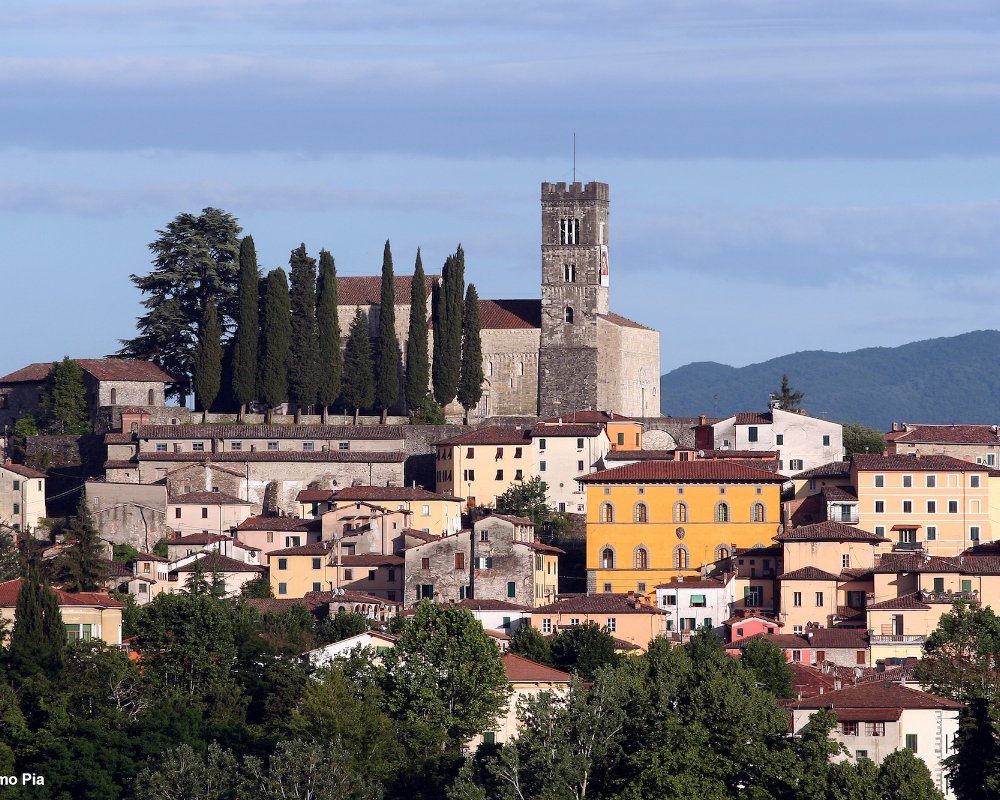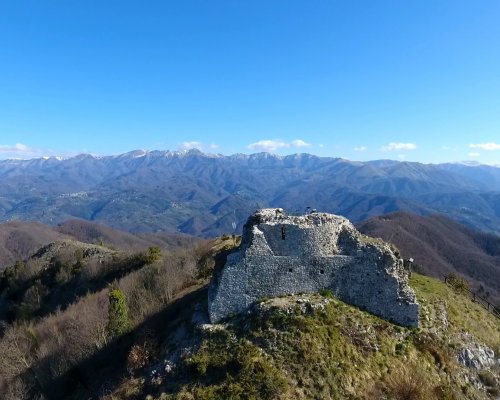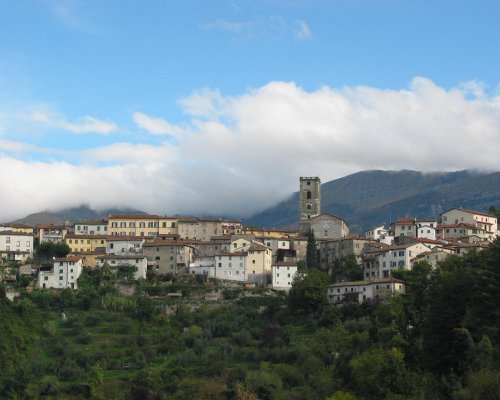Citadels, castles and fortresses, from Borgo a Mozzano to San Romano in Garfagnana
Spend a weekend discovering the Serchio Valley to reach upper Garfagnana and immerse yourself in a unique landscape rich in millenary culture, art and traditions that live on today in the local communities.
From fortresses, ancient villages, medieval churches and bridges to once defensive bulwarks and battle sites, today these places evoke many emotions, with legends and history from the Middle Ages and Renaissance. With this three-day itinerary, you can discover some of the most notable historic sites of the Garfagnana and the mid Serchio Valley.
We start from Borgo a Mozzano, a town known all over the world for the Devil's Bridge with its legends and its unique architecture. However, in this itinerary we will also visit another jewel of the Middle Valley, the Torre del Bargiglio, better known as the eye of Lucca. The tower is located on Monte Bargiglio and dates back to the times of Castruccio Castracani. Later, the eye of Lucca was defined for its fundamental function as an observatory of the Lucchese Republic. Today, starting from the village of Borgo a Mozzano, it is possible to visit it and admire the entire plain of Lucca and the Garfagnana. The tower can be reached by a pleasant walk upwards along centuries-old mule tracks. Wine lovers can stop at the cellars to enjoy a tasting along the way.
From Borgo a Mozzano, we continue towards the Ghivizzano Castle (Municipality of Coreglia Antelminelli), the stronghold of Castruccio Castracani. Following extensive works, it is now possible to admire the entire tower called "Torre di Castruccio". You can also visit the Roman walls and the characteristic via Sossala, an internal street underneath the arches of the walls. Here, costumed historical re-enactments take place every September on the occasion of the I Norcini a Castello festival.
Coreglia is also the perfect place for a tasting of the typical products of the area. Among the best known is the slow food "Bazzone" ham, and the biroldo of the Serchio Valley. For the overnight stay, you can choose to stay on-site or continue to Barga just a few kilometers away, to enjoy a dinner in the characteristic village and continue the tour in the morning.
We start from Borgo a Mozzano, a town known all over the world for the Devil's Bridge with its legends and its unique architecture. However, in this itinerary we will also visit another jewel of the Middle Valley, the Torre del Bargiglio, better known as the eye of Lucca. The tower is located on Monte Bargiglio and dates back to the times of Castruccio Castracani. Later, the eye of Lucca was defined for its fundamental function as an observatory of the Lucchese Republic. Today, starting from the village of Borgo a Mozzano, it is possible to visit it and admire the entire plain of Lucca and the Garfagnana. The tower can be reached by a pleasant walk upwards along centuries-old mule tracks. Wine lovers can stop at the cellars to enjoy a tasting along the way.
From Borgo a Mozzano, we continue towards the Ghivizzano Castle (Municipality of Coreglia Antelminelli), the stronghold of Castruccio Castracani. Following extensive works, it is now possible to admire the entire tower called "Torre di Castruccio". You can also visit the Roman walls and the characteristic via Sossala, an internal street underneath the arches of the walls. Here, costumed historical re-enactments take place every September on the occasion of the I Norcini a Castello festival.
Coreglia is also the perfect place for a tasting of the typical products of the area. Among the best known is the slow food "Bazzone" ham, and the biroldo of the Serchio Valley. For the overnight stay, you can choose to stay on-site or continue to Barga just a few kilometers away, to enjoy a dinner in the characteristic village and continue the tour in the morning.
Barga is one of the most beautiful villages in Italy. For a long time it played a fundamental role in Florentine lordship. Make sure to visit the historic center, nestled in the city walls and the Cathedral of San Cristoforo, perched at the highest point of the village as well as the Multimedia Museum of Fortresses and Fortifications. If you love music, don't miss the Barga Jazz Festival in summer, the important and now historic festival dedicated to jazz music featuring many important artists.
In the late afternoon, we leave the Serchio Valley to continue in Garfagnana, arriving at Castelnuovo Garfagnana. Here, visit the Rocca Ariostesca by crossing the Castruccio bridge, one of the many riches of the town that dominates the main square of the village. Built in the 11th century, it underwent modifications and extensions between the 13th and 14th centuries, including the construction of the large civic tower with a clock, commissioned by Paolo Guinigi. It owes its name to the fact that it hosted the poet Ludovico Ariosto for a short period in the 16th century, while he held the position of governor of the Este province of Garfagnana.
Castelnuovo is also an excellent spot to taste typical Garfagnini products. In the historic center you will find several typical shops, taverns and snack bars where you can enjoy Garfagnino potato bread with local salami and cheeses, as well as spelt IGP cakes, and "il Castagnaccio", the well-known cake made with DOP chestnut flour.
Barga is one of the most beautiful villages in Italy. For a long time it played a fundamental role in Florentine lordship. Make sure to visit the historic center, nestled in the city walls and the Cathedral of San Cristoforo, perched at the highest point of the village as well as the Multimedia Museum of Fortresses and Fortifications. If you love music, don't miss the Barga Jazz Festival in summer, the important and now historic festival dedicated to jazz music featuring many important artists.
In the late afternoon, we leave the Serchio Valley to continue in Garfagnana, arriving at Castelnuovo Garfagnana. Here, visit the Rocca Ariostesca by crossing the Castruccio bridge, one of the many riches of the town that dominates the main square of the village. Built in the 11th century, it underwent modifications and extensions between the 13th and 14th centuries, including the construction of the large civic tower with a clock, commissioned by Paolo Guinigi. It owes its name to the fact that it hosted the poet Ludovico Ariosto for a short period in the 16th century, while he held the position of governor of the Este province of Garfagnana.
Castelnuovo is also an excellent spot to taste typical Garfagnini products. In the historic center you will find several typical shops, taverns and snack bars where you can enjoy Garfagnino potato bread with local salami and cheeses, as well as spelt IGP cakes, and "il Castagnaccio", the well-known cake made with DOP chestnut flour.
After an overnight stay in Castelnuovo, the third day of the itinerary takes us up to the Fortress of Mont’Alfonso, the gateway to the Regional Park of the Apuan Alps. The fortress is so called because it was built by Duke Alfonso II d'Este in 1561 upon the request of locals to have a safe refuge. Inside the walls, in addition to the various buildings that currently house the restaurant, bar and hotel, there is a spectacular park which hosts all kinds of events throughout the year, especially in summer.
We end the itinerary by arriving at the Verrucole Fortress at San Romano di Garfagnana. The earliest mention of the fortification in the village dates back to the early 1000s, indicating that in the Middle Ages it was already the center of various activities for the whole area.
After an overnight stay in Castelnuovo, the third day of the itinerary takes us up to the Fortress of Mont’Alfonso, the gateway to the Regional Park of the Apuan Alps. The fortress is so called because it was built by Duke Alfonso II d'Este in 1561 upon the request of locals to have a safe refuge. Inside the walls, in addition to the various buildings that currently house the restaurant, bar and hotel, there is a spectacular park which hosts all kinds of events throughout the year, especially in summer.
We end the itinerary by arriving at the Verrucole Fortress at San Romano di Garfagnana. The earliest mention of the fortification in the village dates back to the early 1000s, indicating that in the Middle Ages it was already the center of various activities for the whole area.


